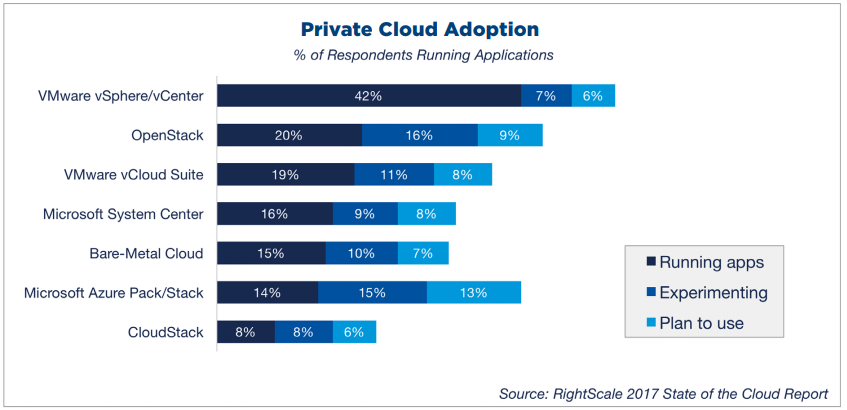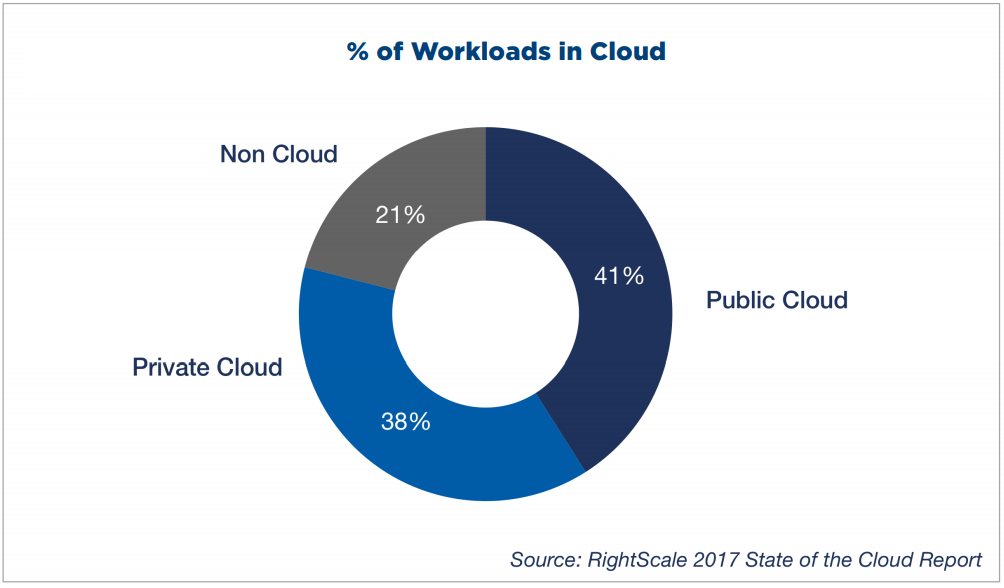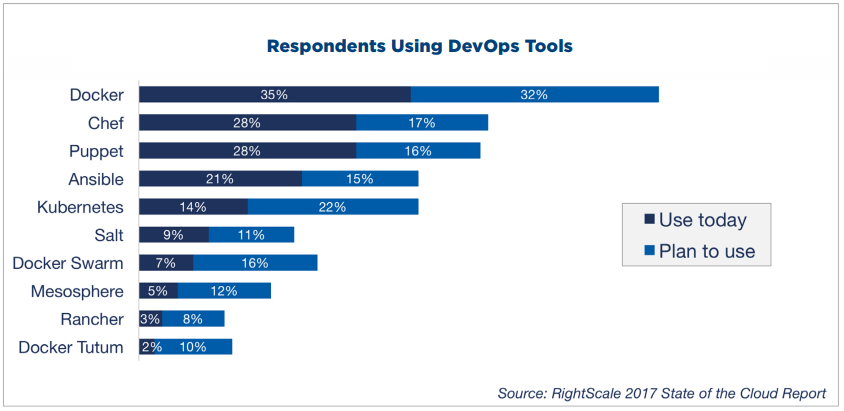How the virtual infrastructure will develop: 4 main trends
Last year, specialists from RightScale conducted a study, during which they surveyed a thousand IT specialists of companies of different profiles and sizes about how their organizations are doing with the introduction of cloud technologies.
In our today's material, we present the most significant IaaS trends from the report and tell about other trends that have found a place in the cloud ecosystem last year.

/ Flickr / stefano meneghetti / CC
')
As described in the research agency Gartner, in 2017 the value of the IaaS market increased immediately by 36.6% and reached $ 35 billion, which made this segment the fastest growing among all cloud services. In this case, it is expected that the trend will continue, and this figure will increase to 56 billion in 2020.
In Reuters, they note that, according to OrbisResearch, by the end of 2017, 40% of global companies had to transfer their capacities to the cloud. And the fastest growing regions in this direction were Latin America, Brazil, and also the countries of the Middle East and Africa.
High rates of IaaS development are also observed in Russia. The results of the CNews rating show that by the end of 2016, the revenue of the ten largest Russian providers grew by 76% - from 3.8 billion to 6.7 billion rubles. The top ten included the company 1cloud, having noted the highest growth in revenue in the period from 2015 to 2016 - 259%.
According to a RightScale survey, 95% of surveyed companies use cloud technologies in their work. Almost 90% of them use a public cloud in their work, and 72% use a private cloud. At the same time, in 2017 there was a slight decrease in interest in private clouds - up to 72% (there were 77% in the 2016 report).

/ RightScale 2017 / CC
At the same time, VMware vSphere remains the leader among private cloud platforms with 42% of the market. It is followed by OpenStack (20%) and VMware vCloud Suite (19%).

/ RightScale 2017 / CC
By reducing the volume of financial investments in private clouds, the companies sent these funds to a different direction - a hybrid cloud. In 2016, the number of companies implementing hybrid solutions increased from 58% to 71% (according to WiseGuyReports).
As for 2017, the number of large companies wishing to implement multi-cloud infrastructure in their own countries amounted to 85%. Moreover, more than half of these organizations seek to build a hybrid infrastructure. Only 9% of corporations continue working with private clouds only, compared to 23% in 2016.
If you look at the distribution of workload in the cloud, then 41% of applications are in a public cloud environment, and 38% are in a private cloud.

/ RightScale 2017 / CC
RightScale respondents named cloud drivers — scalability — 61% —and availability (availability) —56%. Factors such as the efficiency of IT staff and the reduction in infrastructure costs have become slightly less significant, and among the merits of the cloud they were noted by 35% of respondents.
“The ability to change VM configurations at any time, add new and delete old machines gives users virtually unlimited possibilities to optimize the costs of virtual infrastructure for current business needs,” says 1cloud General Manager Vitaly Gritsay.

/ RightScale 2017 / CC
As for the “main fears” that impede the introduction of cloud technologies in companies, popular myths such as the low security of cloud infrastructure and the difficulty of forecasting costs (about the myths of the IaaS sphere, we even prepared a separate series of materials - the first part is available here ). only for 25 percent of respondents, while a year earlier these figures were higher - 29 and 26 percent, respectively.
The DevOps methodology has become widespread and has become a kind of standard in the development of cloud applications. In general, over the past year, 78% of companies turned to DevOps techniques. In large corporations, this figure reached 84%.
Large companies are implementing DevOps gradually, starting with individual development teams and moving to entire departments. However, that year there was a jump in the prevalence of methodology across companies: from 21 to 30 percent.
When mastering the DevOps methodology, companies often decide on the implementation of tools that would automate and standardize the deployment and server configuration processes. These include configuration management applications (for example, Puppet and Ansible), container technologies (Docker) and orchestration systems (Kubernetes, Swarm and Mesosphere).
Docker has become the most popular DevOps tool. It was introduced by 35% of companies, and 32% plan to do this. The closest "competitors" Docker - is Chef and Puppet, which each have 28% of the "market".
Note that the prevalence of Kubernetes has increased over the past year. The number of implementations increased from 7 to 14 percent.

/ RightScale 2017 / CC
If we estimate the percentage of Docker use in companies of different sizes, then this tool is used by 40% of large organizations, and 30% plan its implementation. As for small and medium-sized businesses, here the docker has a “share” of 30%. 33% of companies in this segment plan to start working with it.
Among small companies, Kubernetes showed good growth: from 5 to 12 percent. 21% of respondents plan to appeal to this open solution from Google. At the same time, more and more companies are starting to create tools to support work with Kubernetes: from the recently released utilities, we can mention VMware Dispatch, which we wrote about in our blog on Habré.
While Docker and Kubernetes gained popularity, Chef and Puppet lost their audience. The first lost 7% and 21% of companies work with it, and the second 6% (19% in 2017).
A 2017 study shows that hybrid infrastructure is the most preferred migration to the cloud for enterprises. And organizations are less and less focused on the private cloud.
The main motivators for the transition to the cloud, companies consider to reduce the cost of maintaining the infrastructure and ease of scaling. As for the main factors limiting migration, they lacked experience and security, but they were indicated only by 25% of respondents (compared to 32% and 29%, respectively, in 2016).
As for DevOps, the introduction of appropriate tools across large enterprises is gradually taking place. In 2017, Docker became the leader. Kubernetes has also shown strong growth - this framework has already been implemented by such large organizations as Google, Red Hat, IBM, Microsoft, so we can expect further growth in the popularity of this technology.
In our today's material, we present the most significant IaaS trends from the report and tell about other trends that have found a place in the cloud ecosystem last year.

/ Flickr / stefano meneghetti / CC
')
IaaS - the fastest growing segment of the cloud market
As described in the research agency Gartner, in 2017 the value of the IaaS market increased immediately by 36.6% and reached $ 35 billion, which made this segment the fastest growing among all cloud services. In this case, it is expected that the trend will continue, and this figure will increase to 56 billion in 2020.
In Reuters, they note that, according to OrbisResearch, by the end of 2017, 40% of global companies had to transfer their capacities to the cloud. And the fastest growing regions in this direction were Latin America, Brazil, and also the countries of the Middle East and Africa.
High rates of IaaS development are also observed in Russia. The results of the CNews rating show that by the end of 2016, the revenue of the ten largest Russian providers grew by 76% - from 3.8 billion to 6.7 billion rubles. The top ten included the company 1cloud, having noted the highest growth in revenue in the period from 2015 to 2016 - 259%.
Growing interest in hybrid infrastructure
According to a RightScale survey, 95% of surveyed companies use cloud technologies in their work. Almost 90% of them use a public cloud in their work, and 72% use a private cloud. At the same time, in 2017 there was a slight decrease in interest in private clouds - up to 72% (there were 77% in the 2016 report).

/ RightScale 2017 / CC
At the same time, VMware vSphere remains the leader among private cloud platforms with 42% of the market. It is followed by OpenStack (20%) and VMware vCloud Suite (19%).

/ RightScale 2017 / CC
By reducing the volume of financial investments in private clouds, the companies sent these funds to a different direction - a hybrid cloud. In 2016, the number of companies implementing hybrid solutions increased from 58% to 71% (according to WiseGuyReports).
As for 2017, the number of large companies wishing to implement multi-cloud infrastructure in their own countries amounted to 85%. Moreover, more than half of these organizations seek to build a hybrid infrastructure. Only 9% of corporations continue working with private clouds only, compared to 23% in 2016.
If you look at the distribution of workload in the cloud, then 41% of applications are in a public cloud environment, and 38% are in a private cloud.

/ RightScale 2017 / CC
Scalability - the main advantage of the cloud
RightScale respondents named cloud drivers — scalability — 61% —and availability (availability) —56%. Factors such as the efficiency of IT staff and the reduction in infrastructure costs have become slightly less significant, and among the merits of the cloud they were noted by 35% of respondents.
“The ability to change VM configurations at any time, add new and delete old machines gives users virtually unlimited possibilities to optimize the costs of virtual infrastructure for current business needs,” says 1cloud General Manager Vitaly Gritsay.

/ RightScale 2017 / CC
As for the “main fears” that impede the introduction of cloud technologies in companies, popular myths such as the low security of cloud infrastructure and the difficulty of forecasting costs (about the myths of the IaaS sphere, we even prepared a separate series of materials - the first part is available here ). only for 25 percent of respondents, while a year earlier these figures were higher - 29 and 26 percent, respectively.
The popularity of DevOps is growing
The DevOps methodology has become widespread and has become a kind of standard in the development of cloud applications. In general, over the past year, 78% of companies turned to DevOps techniques. In large corporations, this figure reached 84%.
Large companies are implementing DevOps gradually, starting with individual development teams and moving to entire departments. However, that year there was a jump in the prevalence of methodology across companies: from 21 to 30 percent.
When mastering the DevOps methodology, companies often decide on the implementation of tools that would automate and standardize the deployment and server configuration processes. These include configuration management applications (for example, Puppet and Ansible), container technologies (Docker) and orchestration systems (Kubernetes, Swarm and Mesosphere).
Docker has become the most popular DevOps tool. It was introduced by 35% of companies, and 32% plan to do this. The closest "competitors" Docker - is Chef and Puppet, which each have 28% of the "market".
Note that the prevalence of Kubernetes has increased over the past year. The number of implementations increased from 7 to 14 percent.

/ RightScale 2017 / CC
If we estimate the percentage of Docker use in companies of different sizes, then this tool is used by 40% of large organizations, and 30% plan its implementation. As for small and medium-sized businesses, here the docker has a “share” of 30%. 33% of companies in this segment plan to start working with it.
Among small companies, Kubernetes showed good growth: from 5 to 12 percent. 21% of respondents plan to appeal to this open solution from Google. At the same time, more and more companies are starting to create tools to support work with Kubernetes: from the recently released utilities, we can mention VMware Dispatch, which we wrote about in our blog on Habré.
While Docker and Kubernetes gained popularity, Chef and Puppet lost their audience. The first lost 7% and 21% of companies work with it, and the second 6% (19% in 2017).
General conclusions
A 2017 study shows that hybrid infrastructure is the most preferred migration to the cloud for enterprises. And organizations are less and less focused on the private cloud.
The main motivators for the transition to the cloud, companies consider to reduce the cost of maintaining the infrastructure and ease of scaling. As for the main factors limiting migration, they lacked experience and security, but they were indicated only by 25% of respondents (compared to 32% and 29%, respectively, in 2016).
As for DevOps, the introduction of appropriate tools across large enterprises is gradually taking place. In 2017, Docker became the leader. Kubernetes has also shown strong growth - this framework has already been implemented by such large organizations as Google, Red Hat, IBM, Microsoft, so we can expect further growth in the popularity of this technology.
What else do we write on the 1cloud blog:
Source: https://habr.com/ru/post/348752/
All Articles